 Welcome
Welcome
“May all be happy, may all be healed, may all be at peace and may no one ever suffer."
- A
- B
- C
- D
- E
- F
- G
- H
- I
- J
- K
- L
- M
- N
- O
- P
- Q
- R
- S
- T
- U
- V
- W
- X
- Y
- Z
Hives - Homeopathic remedies
Hives, also known as urticaria, is a skin condition characterized by the appearance of raised, itchy, red welts on the skin. The welts can vary in size and shape and may be round, oval or even irregular in shape. They can appear on any part of the body and may last from a few hours to several days.
Hives are caused by the release of histamine and other chemicals from cells called mast cells in the skin. This can occur as a result of an allergic reaction to certain foods, medications, or environmental triggers such as pollen, insect bites or exposure to sunlight. In some cases, hives can also be triggered by stress or exercise.
The symptoms of hives can be mild to severe, and they can vary from person to person. Common symptoms include itching, swelling, and redness of the skin. In some cases, hives can cause a burning or stinging sensation on the skin. If hives occur in the mouth or throat, they can cause difficulty breathing or swallowing, which can be life-threatening.
Treatment for hives usually involves avoiding triggers that may cause an allergic reaction, taking antihistamines, and in some cases, corticosteroids. In severe cases, hospitalization may be necessary, and the patient may require intravenous medications to control the symptoms.
If you experience hives, it is important to see a healthcare professional for an accurate diagnosis and appropriate treatment. While hives are usually not serious, in some cases, they can be a sign of an underlying medical condition that requires further evaluation and treatment.

Indigestion

Anal fistula

Ear infection

Nocturnal emission

Headache

Rheumatism

Swollen tongue

Cold
Hives, আমবাত
To be happy, beautiful, healthy, wealthy, hale and long-lived stay with DM3S.







